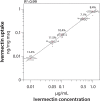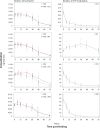The pharmacokinetics and drug-drug interactions of ivermectin in Aedes aegypti mosquitoes
- PMID: 33730100
- PMCID: PMC7968666
- DOI: 10.1371/journal.ppat.1009382
The pharmacokinetics and drug-drug interactions of ivermectin in Aedes aegypti mosquitoes
Abstract
Mosquitoes are vectors of major diseases such as dengue fever and malaria. Mass drug administration of endectocides to humans and livestock is a promising complementary approach to current insecticide-based vector control measures. The aim of this study was to establish an insect model for pharmacokinetic and drug-drug interaction studies to develop sustainable endectocides for vector control. Female Aedes aegypti mosquitoes were fed with human blood containing either ivermectin alone or ivermectin in combination with ketoconazole, rifampicin, ritonavir, or piperonyl butoxide. Drug concentrations were quantified by LC-MS/MS at selected time points post-feeding. Primary pharmacokinetic parameters and extent of drug-drug interactions were calculated by pharmacometric modelling. Lastly, the drug effect of the treatments was examined. The mosquitoes could be dosed with a high precision (%CV: ≤13.4%) over a range of 0.01-1 μg/ml ivermectin without showing saturation (R2: 0.99). The kinetics of ivermectin were characterised by an initial lag phase of 18.5 h (CI90%: 17.0-19.8 h) followed by a slow zero-order elimination rate of 5.5 pg/h (CI90%: 5.1-5.9 pg/h). By contrast, ketoconazole, ritonavir, and piperonyl butoxide were immediately excreted following first order elimination, whereas rifampicin accumulated over days in the mosquitoes. Ritonavir increased the lag phase of ivermectin by 11.4 h (CI90%: 8.7-14.2 h) resulting in an increased exposure (+29%) and an enhanced mosquitocidal effect. In summary, this study shows that the pharmacokinetics of drugs can be investigated and modulated in an Ae. aegypti animal model. This may help in the development of novel vector-control interventions and further our understanding of toxicology in arthropods.
Conflict of interest statement
The authors have declared that no competing interests exist.
Figures




Similar articles
-
Cytochrome P450/ABC transporter inhibition simultaneously enhances ivermectin pharmacokinetics in the mammal host and pharmacodynamics in Anopheles gambiae.Sci Rep. 2017 Aug 17;7(1):8535. doi: 10.1038/s41598-017-08906-x. Sci Rep. 2017. PMID: 28819225 Free PMC article.
-
High concentrations of membrane-fed ivermectin are required for substantial lethal and sublethal impacts on Aedes aegypti.Parasit Vectors. 2021 Jan 6;14(1):9. doi: 10.1186/s13071-020-04512-5. Parasit Vectors. 2021. PMID: 33407825 Free PMC article.
-
Enhanced mortality in deltamethrin-resistant Aedes aegypti in Thailand using a piperonyl butoxide synergist.Acta Trop. 2019 Jan;189:76-83. doi: 10.1016/j.actatropica.2018.09.025. Epub 2018 Oct 1. Acta Trop. 2019. PMID: 30287252
-
A Roadmap for the Development of Ivermectin as a Complementary Malaria Vector Control Tool.Am J Trop Med Hyg. 2020 Feb;102(2s):3-24. doi: 10.4269/ajtmh.19-0620. Am J Trop Med Hyg. 2020. PMID: 31971144 Free PMC article.
-
Ivermectin to reduce malaria transmission I. Pharmacokinetic and pharmacodynamic considerations regarding efficacy and safety.Malar J. 2017 Apr 24;16(1):161. doi: 10.1186/s12936-017-1801-4. Malar J. 2017. PMID: 28434401 Free PMC article. Review.
Cited by
-
Next Generation Neuropeptide Y Receptor Small Molecule Agonists Inhibit Mosquito Biting Behavior.bioRxiv [Preprint]. 2024 Mar 5:2024.02.28.582529. doi: 10.1101/2024.02.28.582529. bioRxiv. 2024. Update in: Parasit Vectors. 2024 Jun 28;17(1):276. doi: 10.1186/s13071-024-06347-w. PMID: 38464241 Free PMC article. Updated. Preprint.
-
Pharmacokinetics of ivermectin metabolites and their activity against Anopheles stephensi mosquitoes.Malar J. 2023 Jun 24;22(1):194. doi: 10.1186/s12936-023-04624-0. Malar J. 2023. PMID: 37355605 Free PMC article.
-
Next-generation neuropeptide Y receptor small-molecule agonists inhibit mosquito-biting behavior.Parasit Vectors. 2024 Jun 28;17(1):276. doi: 10.1186/s13071-024-06347-w. Parasit Vectors. 2024. PMID: 38937807 Free PMC article.
References
-
- World health organization (2020). Vector-borne diseases, Fact sheet no. 387 2014. Available from: https://www.who.int/news-room/fact-sheets/detail/vector-borne-diseases. [Accessed: 03-February-2021].
-
- World health organization (2019). World malaria report 2019: Geneva. Available from https://www.who.int/publications/i/item/world-malaria-report-2019. [Accessed: 03-February-2021].
MeSH terms
Substances
LinkOut - more resources
Full Text Sources
Other Literature Sources

